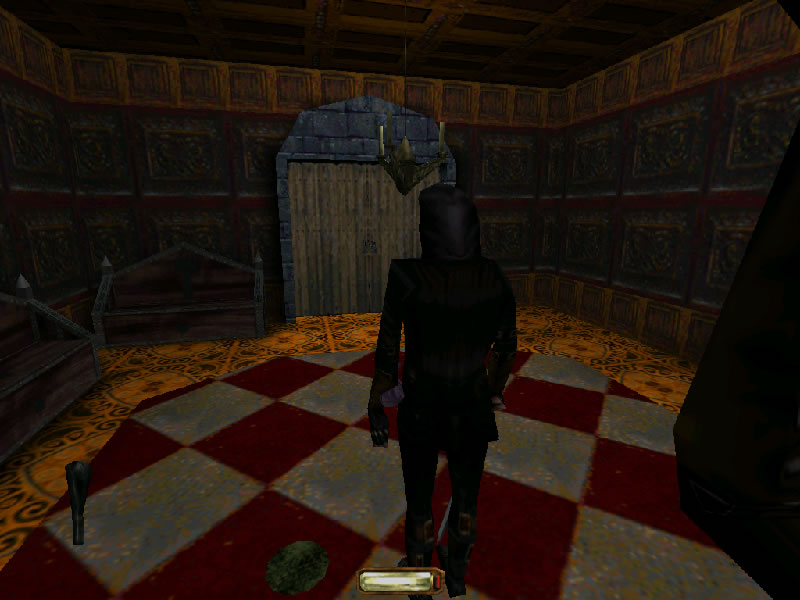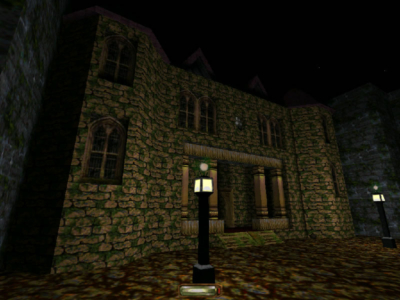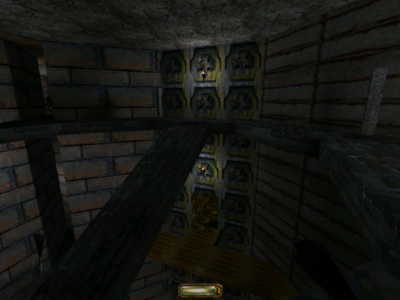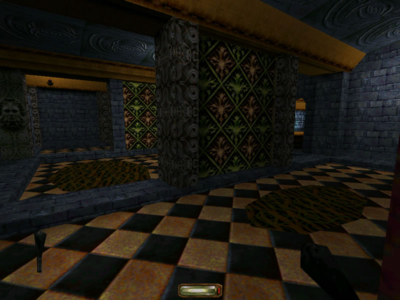
Thief: The Dark Project
Written by: Stoo
Date posted: May 16, 2005
- Genre: Action
- Developed by: Looking Glass Studios
- Published by: Eidos
- Year released: 1998
- Our score: 10
Looking back, 1998 was a pretty important time for first-person action. This was the year that Valve brought us Half-Life, which played such an important part in moving shooters from killfests and key hunts to something more story-driven. It also saw the likes of Sin and Shogo which were doomed to be also-rans compared to Valve’s masterpiece, but still decent games in their own right. However, on top of all this was something a bit different from Looking Glass studios.
Over the course of the 90s, LG had established themselves as makers of immersive first-peron titles. Ultima Underworld in 1992 was an action-RPG which boasted the most advanced 3D engine of its time. A couple of years later System Shock was praised as a kind of “thinking man’s Doom”, a first shooter but with a slower pace and more involving gameplay. Then Terra Nova brought us awesome futuristic squad-based combat, even if unfortunately no-one actually bought it.
When they returned with a new project at the tail-end of the decade, LG had a new take on the genre. Here’s the idea: you take on the role of Garrett, the master thief, in a fantasy medieval setting (just how fantasy, we’ll get onto in a second). He is the undisputed expert of his craft, able to break into the most secure of locations, evade guards and traps with ease, and steal the choicest loot. Not just some regular burglar, he regularly plunders from the targets that are the most well guarded, but also most profitable. Wealthy noblemen, powerful religious orders, even major crime lords are all at risk from Garrett. His goal is to rob from the rich and give to himself, so that one day he can retire in style.
So this isn’t a game of fast-paced action, but rather stealth. After all you’re a thief and not a warrior. Charging headlong at something with your sword drawn isn’t an approach likely to go down well. You can fight if you wish, even maybe beat a guard, but if outnumbered you’re probably screwed. So to survive you lurk in the shadows and avoid drawing attention to yourself. If you must take action, a surprise attack from behind is always preferable to an open fight.
The game is split into a number of missions starting with an obligatory obstacle-course style tutorial level (which also sets up some story elements). The first proper level is then a job on the home of a local Lord. The idea is simple; go relieve him of excess wealth. Your break in through the sewers (well, feel free to charge the heavily guarded front door if you wish). Once inside you stick to the shadows, do your best not to give yourself away, and dodge the oafish guards who strut about whistling to themselves. Moving softly from kitchen to hallway to bedroom, you help yourself to golden goblets and piles of coins. Sooner or later you should fine the main prize of this mission, some sort of extra-valuable trinket. The one last objective is then to return to the anonymous safety of the city streets. Another night’s hard work, done.
So that’s it then, a game of various challenges based on robbing from the rich in something more or less like the 13th century? Well, not quite. On the very next level, things get a bit weird – when infiltrating a prison from the caverns below, flesh-craving zombies come shuffling at you from out the the gloom. The next map which is essentially a grand tomb-robbing adventure, except the tomb is guarded by yet more undead. Later maps bring in further fantasy factors, like mages, and also strange bestial semi-humanoids.
So right away we’ve reached one of the controversial features of Thief. Some reviewers reacted badly to this side to the game, saying it had abandoned a promising core premise and gotten a bit silly with a romp into worlds of wizards and skeletons. Just to be clear from the start, I don’t really agree. Thematically, the setting still works – fantasy stealth and thieving can still be just as fun as realistic medieval thieving. I would agree there’s a bit of a change of pace though – for various reasons stealth feels just a bit less important against inhuman enemies. Still I don’t think the game suffers too badly, and headlong sword-waving charge still are rarely a good idea. Overall, as I’ll try to explain, the implementation is nearly all of a consistently high quality. You just have to accept there’s as much tomb raiding as, er… mansion-raiding.
Anyway with these basic principles established, we can look at how Thief goes about its stealthy business. The single most important part is simply staying out of sight. A handy “light gem” on your monitor lets you know how well-illuminated you currently are. If standing right next to a lamp then obviously enough you can be seen from way off. However, the maps are liberally scattered with dark areas, and when lurking in a shadow the light gem goes dim. In these places you’re virtually invisible; to the point where an enemy can stroll right past, oblivious to you.
There’s also sound to consider; walking on grass or carpets is safe enough but some floors are much noisier and your clattering footsteps on a metal walkway could alert nearby guards. At first it seems kind of unrealistic – wouldn’t Garret invest in some soft-soled boots? I interpret it though as the game exaggerating small sounds for the sake of keeping you alert. Other sound related blunders you can make include dropping heavy items, or whacking your sword against something.
To go with this is a fairly advanced system of enemy AI, designed to react to stimuli you might produce through an unstealthy blunder. It works by having several levels of awareness, the base setting being completely oblivious. If you, say, let a guard briefly glimpse you, he might mutter “that’s odd” and become a bit more alert, but will otherwise stick to his post or patrol route. Make a bigger mistake, though, or even just further small errors on top of the first one, and he might start actively looking for you. At this point you have to be really careful, or you’re going to get in a lot of trouble. Also though because of the AI system, the use of sound works both ways; you can get a good idea what an unseen enemy is up to, or how cautious he’s currently feeling, just by listening to what he’s muttering to himself. Even beastial foes make more alert-sounding growls.
To help you remain un-noticed there’s a range of handy tools. It’s significant that only a few items you carry in this game count as offensive weaponry, the rest are to help you avoid needing that weaponry in the first place. Water arrows will douse flame-based light sources from a distance, moss arrows create a soft carpet to walk on. Flashbombs temporarily blind guards, allowing for a hasty escape. Trusty lockpicks meanwhile save the effort of finding a key or noisily battering a door open with your sword.
If you want you can try just completely avoiding the enemies at all times; indeed hardcore Thief fans often deem this the ideal way to play. Sometimes though it can help a lot to incapacitate a guard. Again though, charging forth and starting a fight isn’t ideal. Rather, your best bet is to sneak up from behind and launch a surprise attack. You can stab them with your sword, or snipe them from a distance with an arrow. Oblivious foes go down in one hit, but when alerted they can take a lot more punishment from your sword and bow. It’s another point that seems unrealistic, but again the emphasis is on pushing you to avoid open confrontations.
Fighting isn’t just tactically unsound – on higher difficulty settings you’re forbidden from killing humans. On expert, even armed ones. After all you’re master of the elegant art of thieving, not some murderer, and bloodshed is messy and unprofessional. As it happens, I felt kind of bad about killing anyway. Guards clutch themselves, groan, and collapse and for the first time in gaming I’ve found myself asking “was that really necessary?” Fortunately the humble blackjack will knock them out cold non-lethally, although it’s useless once they’re aware of you.
With monstrous foes, you might find the pace changes a bit, albeit with some dependence on personal preference. For one thing Zombies are so slow you can often just dash past without caring if they see you, as long as you have somewhere to escape to. Also the “no killing” expert rule doesn’t apply to monsters. If you weren’t playing on expert or didn’t care about killing guards anyway, this won’t make a difference. For me though it did mean a feeling of the gloves coming off and going more on the offensive. Especially when one of your items – used to temporarily blind humans – doubles an anti-undead grenade. That said, as mentioned, stealth is still usually the best way to survive.
Anyway mention difficulty settings – as well as restricting your violence, they alter how much damage Garrett can take. Also they alter mission objectives; for example on the lowest you might just have to break in to a place and steal something. Harder settings, however, require you to get back out again afterwards. You’ll probably be told to unearth one or two further special trinkets too. Also on any map there’s a fair amount of generic loot, as well as specific objectives, that counts towards a numerical score. Harder settings mean you have to track down more loot – be it in the form of gold, jewels or ornaments. In this way, if you’ve played through once on the easiest setting Thief tempts you to come back for another go, by adding further objectives.
Whatever happens though, something key to Thief‘s ethos is that “remain undetected” is never a compulsory objective. If you get spotted and the alarm is raised, you won’t have MISSION FAILED thrown in your face. You’re probably now in a really dangerous situation, possibly even completely shafted. However, you’re always given a chance to save your skin. If you don’t want to stand and fight you can run like a girl and find a hiding place. If they lose track of you for long enough the guards will hunt around for a while but then give up. Running won’t always work, but you can at least try.
That’s the mechanics of play, anyway, and they’re very well done. Getting the hang of thieving takes patience, for sure. It works at a much slower pace than shooters. You have to sit quietly and take the time to watch enemies, get an idea of their patrol routes, and wait for the right moment to take action. That might be striking with a weapon, or dashing to the next hiding place. If you’re after a constant stream of action, this is the wrong game.
It is, however, immensely satisfying when you get it right. There’s a feeling of power of being concealed up in the rafters, watching guards stroll past underneath, oblivious to the master thief. After that comes the glee of finding the shiny gold things those guards where supposed to be watching, and swiping the load for yourself. There’s also the thrill of evading the dangers of some dark haunted place – or quietly eliminating them if you’re feeling brave – and finally stumbling across the shrine full of treasure that you’ve been searching for the past hour.
Anyway though, with all that established we can look in more detail at some of the specific missions, which take place in, near or under the un-named City. I mentioned mansion runs – one great mission starts off with you narrowly avoiding an assassination attempt by some hired goons. You trail them across the city streets, back to the home of the crime boss they work for, then rob him blind as Garrett’s idea of compensation. Urban locations like this still look pretty convincing, despite the Dark Engine’s age – there are cold bare servant’s quarters, libraries, tiled bathrooms and more luxurious areas for the lordships themselves. So it’s quite fun to poke around and see what you can swipe; candlesticks, purses and even expensive wine.
Not every mission is fantastic – one that has you navigating sewers between two crime bosses’ homes can be pretty frustrating. Although you carry maps for each mission that highlight your current location, they can be rather vague. To quote an old text adventure “you are in a maze of twisty passages, all alike”. To make up for it though, a later map sees you infiltrate a fully featured opera house – on a mission to rob from the wealthy guests, the owner, the stars, even the servants if you’re feeling heartless. When you think that it was only a year since Quake 2 was throwing us masses of abstract brown corridors, it’s quite an achievement of design.
For more adventurous locations though I mentioned grave robbing – the underground tomb complex known as the Bonehoard is in fact one of the greatest experiences in the game. It’s a vast underground lair where winding passages open out onto ancient shrines and and lofty vaults. Full of ancient treasures but also traps and undead watchers. You start in at the surface, then make your way through crypts and caves, then head even further down past a huge subterranean crack in the earth into the tombs proper. There’s a terrific feel of the deep places beneath the deep places, ancient and ominous and brooding beneath the cold earth. The detailing is rich and ornate, the tombs magnificent, and you… feel very alone. But hey, shiny things beckon.
To go with that is an adventure crossing the ruined old quarter of the City, where zombies now fight it out with beasts and giant spiders. Much of the city feels old and grimy – this is the logical conclusion of that theme, where everything has fallen into rot and ruin. Yet there are treasures, and a few interesting sights, for a brave thief. A followup to this one focusses on the haunted cathedral, and here the game comes closest to an outright scary experience. Just wait till you try frantically picking the lock on a door to some place of safety, while something horrible and shadowed hunts for you, talking in creepy backwards babble.
What else… there’s the Mage’s tower. And another underground adventure goes for a whole other style, of an entire lost city with a vaguely Mesoamerican theme, now over-run with giant lizards. I shouldn’t give too much away, other than to acknowledge that the last few probably aren’t the greatest. Well, they have a great sense of atmosphere still – in fact damn creepy in a whole new way not zombie-related. Think rather the theme of something wild and chaotic from the forest, gnawing its way up into the city. The implementation though feels just a little too crowded with monsters, to the point where I did end up going a bit Rambo and filling rat-men with arrows.
Anyway though, few more general points to cover. Apart from feeling right, the maps are well structured for your thieving challenge. For one thing they’re often quite large. Also, there’s often no one fixed path through. Instead, you’re given a large degree of freedom to move around, and find your own way. Because of this objectives can often be completed in any order, and if you find a problem you might be able to approach it from another direction or bypass it altogether. After all as mentioned, no sensible thief goes in through the front door. A minute or two’s searching should find another, quieter way in, be it through the sewers or over the rooftops.
Indeed the best plan is to explore thoroughly; you could just dash from one objective to the next, but it’s often more fun and profitable to take the time to look around. You might find a hidden cache, or a secret route to some other part of the map. To aid you in your exploring, the game gives Garrett the ability to climb onto ledges. It’s a fairly simple feature when you think about it, but worthwhile when you remember how frustrating it is being stopped by a 1-2 metre wall in other first-person games. There are also special rope arrows which function as grappling hooks, allowing you to get into all manner of places; up in the rafters or on top of a building. Thus it helps with that sense of freedom of movement in maps – being able to scramble around and climb all over many obstacles.
The soundtrack must also be mentioned. It works to the principle that less is more – a full blown musical score would probably be too much, and spoil the effect. So we’re given effects like maybe just a few sparse chords, or a low ominous rumble, or the wail of a lonely horn in the distance. Or in one instance, a woman’s disembodied mocking laugh as you attempt to cross a labyrinth. It really is very effective in helping to set the scene.
Betweeen missions there’s a narrative holding events together, which helps explain some of the supernatural stuff. The first few missions are really just business as usual for Garrett, but the story kicks in after a normal-seeming job takes a turn for the surreal inside. This leads to him being commissioned to steal some extra-special items for a mysterious nobleman. It’s not the most elaborate of stories, and does feel a bit like it was sketched between missions. Still this was back in the days when first-person games were only beginning to be story driven at all, after years of the likes of Quake. With that in mind, <i>Thief</i> does stand out. It also sets up a theme of the talented Thief facing up to the responsibilities that his near-supernatural powers bring, which would continue throughout the sequels.
To help it along between missions are some excellent cutscenes. While I’ve come to like the kind of seamless, in-engine approach use by Half-Life, these animations are really well done. Rather than slightly plastic-looking pre-rendered computer graphics that tended to blight gaming in the latter half of the decade, they’re done in an evocative hand-drawn style. So it’s like getting a slightly different look at the grimy and shadowed world of Thief, glimpses of rainswept rooftops, grim guards and furtive or sinister figures.
Garrett himself is certainly brought to life well, thanks to some talented voice acting, and he’s a welcome addition to our FFG hall of gravelly-voiced heroes. Well, to be fair he’s not a shiny hero – this guy does take other people’s stuff for a living after all. But he’s not a cliché of a dark anti-hero either; there’s no melancholy brooding while he sits on a rainswept rooftop. Instead, he’s just rather cynical and sardonic, with the justified arrogance of a professional who’s the best at what they do and a large dose of contempt for the wealthy fools he preys on. He also chips in with a few wry observations in-game during missions – “heh, guess I outstayed my welcome”.
This is a resoundingly positive review, so in case I sound like a crazy fanboy, I should acknowledge a few flaws. The character models look pretty poor thanks to low polygon counts. Even by the standards of the day they were backward compared to say Half-Life. So it’s a good thing they’re shrouded in darkness a lot of the time. A few features meanwhile aren’t as well implemented as they could be; sometimes Garrett just bounces off ropes and falls to his death, and noisemakers don’t seem to distract guards so much as just throw them into general alert mode. Oh and, as mentioned, the last few levels are below-par (how often do we find ourselves thinking that).
Apart from that, you might still decide you prefer the more realistic urban settings to crypts and monsters. In which case I’d suggest you take a look at the sequel. It dumps the zombies, has more in the way of banks and warehouses and guys with swords and bows are usually the main foe.. However it does also heavily ramp up the Steampunk side, which is another kind of fantasy setting with its own novel threats. Myself I really just think of them as two chapters of the wider experience anyway. This is the grimy medieval one with supernatural threats, Thief 2 is the pseudo-victorian one with steam-powered robots. (no, really).
Anyway though, unless you just really hate fantasy, this one is a resounding success. The mechanics of stealthy play are really well done, and combined with the relative freedom of action the game still handles well, ten years on. Also though, it’s simply one of the most atmospheric experiences I’ve yet come across. The sneaky style plays a part as does the setting, the design, and the soundtrack. It’s hard to for a clunky writer like myself to adequately pin down with words; they best I can offer is a sense of eerie tension. It’s most obvious in the supernatural parts, but always there in some form. Rarely outright “scary”, just haunting. A feeling that you’re intruding, that you don’t belong, that it feels gloomy and oppressive here.. But you’re the master of the shadows, and you’re greedy, so you relish it anyway.
In other words, another fantastically well-crafted piece of gaming from Looking Glass. Not 100% perfect, but it’s not our policy to demand that for a top score here anyway. If only cos we can nitpick anything if we try hard enough. Since 1998 other games have had a go at stealth, with much shinier graphics by now, but it’s arguable that the Thief series is still unmatched on some counts. I think it’s significant that a small but enthusiastic fanbase is still churning out their own levels for the game, eight years after its release. That’s the kind of following it earned.
Basically, this is the kind of game that I’ve often been completely absorbed in. To the point of completely losing track of the real world around me, the need to eat dinner and the fact that it’s 3 am. That’s about as high a praise as any gaming review can offer, surely?





 Posts
Posts
I actually played this for the first time in 2013 and was completely blown away. Extremely immersive world with perhaps the best level design I’ve ever seen. Exploring every corner of the maps with the rope arrow was very fun.
The Sword, Return to the Cathedral and The Lost City were my favourites. I’ll have to reinstall it now thanks to your review!
October 2, 2015 @ 1:37 am